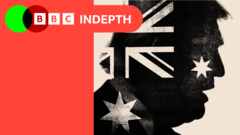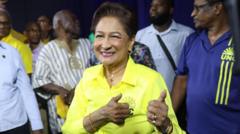In a bid to regain support from Chinese Australian voters, the opposition has turned to popular Chinese social media platforms like WeChat. This strategic move comes as candidates aim to win crucial marginal seats ahead of the upcoming election. Chinese Australians have historically leaned conservative but have shifted towards Labor due to perceived political missteps.
Australian Opposition Courts Chinese Voters Through Social Media Strategy

Australian Opposition Courts Chinese Voters Through Social Media Strategy
With the election approaching, Australia's opposition is leveraging Chinese social media platforms to reconnect with Chinese Australian voters, a group that previously distanced itself from the Liberal-National coalition.
As Australia moves closer to the election, the opposition parties are intensifying their outreach to a vital demographic: Chinese Australian voters. This group, which has shown itself to be pivotal in electoral shifts, especially following the 2022 elections, now finds itself courted through channels that were once regarded with suspicion by the same parties.
Polling indicates that nearly 60% of Chinese Australians utilize WeChat daily, making it a prime communication platform as candidates vie for their attention. One prominent candidate, Grange Chung, is contesting the New South Wales seat of Reid, currently held by the Labor party. In a recent WeChat video, Chung expressed his commitment to serving the community that welcomed his family. His efforts are emblematic of a broader trend where candidates are adopting local cultural touchstones in their campaigns.
Chinese Australians constitute only 5.5% of the national population, yet their voting power became evident in the recent past as they significantly influenced Labor's victory over the Conservative Coalition. Analysts suggest that factors such as COVID-19-related racism and harmful government rhetoric regarding China contributed to this demographic's shift away from traditional conservative alignments.
Liberal candidates recognize the need to reclaim this lost support, particularly in marginal seats with substantial Chinese populations, such as Burwood, an area known for its Chinese community. Chung's campaign has seen him actively engaging with the community through video content on WeChat and celebrating local events.
Moreover, targeted advertising from Liberal candidates on WeChat has seen substantial growth, with over 220 authorized ads compared to Labor’s 35 since January. Voter engagement on platforms like WeChat is seen by some residents as an effective means for political discourse, making it a crucial battleground.
However, while enhancing visibility on Chinese social media could boost engagement, experts caution that it does not necessarily guarantee voter loyalty. Growing political awareness among Chinese Australians suggests a readiness to consider independent candidates who may resonate better with local needs.
This rising sentiment has led to frustrations within the community, as some feel they are being used simply for electoral gains. Instances of negative media portrayal and accusations of disloyalty towards Chinese Australians serve to complicate their engagement with traditional parties.
In Bennettlong, where nearly one-third of the population has Chinese ancestry, campaign strategies have included Mandarin subtitling in WeChat posts to reach a broader audience, given the lower English proficiency in the area. There exists an urgent need for the Liberal party to align its social media outreach with a coherent and inclusive political message to alleviate voter anxieties regarding migration and international relations.
As candidates navigate these complex waters, the effectiveness of their digital strategies will be put to the test in the upcoming elections, revealing whether outreach on platforms like WeChat can reverse the trends seen in the last election cycle.



















